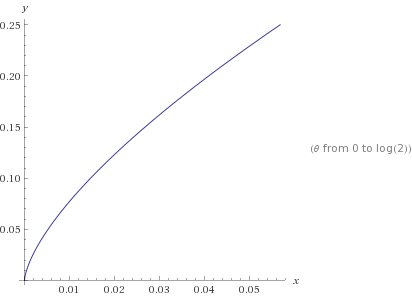A calculus problem by Rocco Dalto

The solution to the differential can be expressed as the arc , , and the curve passes thru the origin so that , when .
The volume formed by rotating the above curve , about the -axis from to can be expressed as , where and are pairs of coprime positive integers.
Find:
Refer to previous problem. . .
The answer is 182.
This section requires Javascript.
You are seeing this because something didn't load right. We suggest you, (a) try
refreshing the page, (b) enabling javascript if it is disabled on your browser and,
finally, (c)
loading the
non-javascript version of this page
. We're sorry about the hassle.
2 1 ∗ ( d x d y ) 2 − y a = 2 1 ⟹
d x d y = y 2 a + y ⟹ x = ∫ 2 a + y y d y
Let u 2 = y ⟹ 2 u d u = d y ⟹
x = 2 ∗ ∫ 2 a + u 2 u 2 d u
Let u = 2 a s i n h ( θ ) ⟹ d u = 2 a c o s h ( θ ) d θ ⟹
x = 2 a ∗ ∫ ( c o s h ( 2 θ ) − 1 ) d θ = 2 a ∗ ( 2 1 s i n h ( 2 θ ) − θ ) ) = a ∗ ( s i n h ( 2 θ ) − 2 θ ) + C .
x ( θ ) = 0 ⟹ C = 0 ⟹ X = a ∗ ( s i n h ( 2 θ ) − 2 θ ) )
x = u 2 = 2 a ∗ s i n h 2 ( θ ) = a ∗ ( c o s h ( 2 θ ) − 1 ) .
Replacing 2 θ by θ we obtain:
x = a ∗ ( s i n h ( θ ) − θ ) , y = a ∗ ( c o s h ( θ ) − 1 )
Now we rotate the curve about the x - axis from θ = 0 to θ = ln ( 2 ) .
The Volume V = π ∫ 0 ln ( 2 ) ( y ( θ ) ) 2 d θ d x d θ
a 3 π ∗ ∫ 0 ln ( 2 ) ( c o s h ( θ ) − 1 ) 3 d θ =
a 3 π ∗ ∫ 0 ln ( 2 ) ( c o s h 3 ( θ ) − 3 c o s h 2 ( θ ) + 3 c o s h ( θ ) − 1 ) d θ =
a 3 π ∗ ∫ 0 ln ( 2 ) ( ( 1 + s i n h 2 ( θ ) ) c o s h ( θ ) − 2 3 ( c o s h ( 2 θ ) + 1 ) + 3 c o s h ( θ ) − 1 ) d θ =
a 3 π ∗ ∫ 0 ln ( 2 ) ( 4 c o s h ( θ ) + s i n h 2 ( θ ) ∗ c o s h ( θ ) − 2 3 c o s h ( θ ) − 2 5 ) d θ =
a 3 π ∗ ( 4 s i n h ( θ ) + 3 s i n h 3 ( θ ) − 4 3 s i n h ( 2 θ ) − 2 5 ) ∣ 0 ln ( 2 ) =
a 3 π ∗ ( 3 + 6 4 9 − 3 2 4 5 − 2 5 ln ( 2 ) ) =
a 3 π ∗ ( 6 4 1 1 1 − 2 5 ln ( 2 ) ) = a 3 π ∗ ( n m − q p ∗ ln ( q ) )
⟹ m + n + p + q = 1 8 2 .